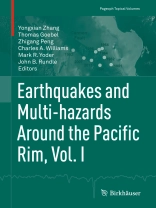This is the first of two volumes devoted to earthquakes and multi-hazards around the Pacific Rim. The circum-Pacific seismic belt is home to roughly 80% of the world’s largest earthquakes, making it the ideal location for investigating earthquakes and related hazards such as tsunamis and landslides. Gathering 16 papers that cover a range of topics related to multi-hazards, the book is divided into three sections: earthquake physics, earthquake simulation and data assimilation, and multi-hazard assessment and earthquake forecasting models.
The first section includes papers on laboratory-derived rheological parameters as well as seismic studies in the Gulf of California and China. In turn, the second section includes papers on improvements in earthquake simulators as well as the statistical methods used to evaluate their performance, automated methods for determining fault slip using near-field interferometric data, variabilities in earthquake stress drops in California, and the use of social media data to supplement physical sensor data when estimating local earthquake intensity. The final section includes a paper on probabilistic tsunami hazard assessment, several papers on time-dependent seismic hazard analysis around the Pacific Rim, and a paper on induced and triggered seismicity at the Geysers geothermal field in California.
Rapid advances are being made in our understanding of multi-hazards, as well as the range of tools used to investigate them. This volume provides a representative cross-section of how state-of-the-art knowledge and tools are currently being applied to multi-hazards around the Pacific Rim. The material here should be of interest to scientists involved in all areas of multi-hazards, particularly seismic and tsunami hazards. In addition, it offers a valuable resource for students in the geosciences, covering a broad spectrum of topics related to hazard research.
विषयसूची
Earthquakes and Multi-hazards around the Pacific Rim, Vol. 1: Introduction.- Scaling law of average failure rate and steady-state rate in rocks.- Apparent Dependence of Rate- and State-Dependent Friction Parameters on Loading Velocity and Cumulative Displacement Inferred from Large-Scale Biaxial Friction Experiments.- Source Functions and Path Effects from Earthquakes in the Farallon Transform Fault Region, Gulf of California, Mexico that Occurred on October 2013.- Stress Distribution Near the Seismic Gap Between Wenchuan and Lushan Earthquakes.- Parametrizing Physics-Based Earthquake Simulations.- Spatial Evaluation and Verification of Earthquake Simulators.- Radar Determination of Fault Slip and Location in Partially Decorrelated Images.- Detecting Significant Stress Drop Variations in Large Micro-Earthquake Datasets: A Comparison Between a Convergent Step-Over in the San Andreas Fault and the Ventura Thrust Fault System, Southern California.- Real-Time Earthquake Intensity Estimation Using Streaming Data Analysis of Social and Physical Sensors.- The Dependency of Probabilistic Tsunami Hazard Assessment on Magnitude Limits of Seismic Sources in the South China Sea and Adjoining Basins.- Can Apparent Stress be Used to Time-Dependent Seismic Hazard Assessment or Earthquake Forecast? An Ongoing Approach in China.- An Ensemble Approach for Improved Short-to-Intermediate-Term Seismic Potential Evaluation.- Reducing False Alarms of Annual Forecast in the Central China North–South Seismic Belt by Reverse Tracing of Precursors (RTP) Using the Pattern Informatics (PI) ‘Hotspots’.- Test of the Predictability of the PI Method for Recent Large Earthquakes in and near Tibetan Plateau.- Long-Term Seismic Quiescences and Great Earthquakes in and Around the Japan Subduction Zone Between 1975 and 2012.- Statistical Studies of Induced and Triggered Seismicity at The Geysers, California












